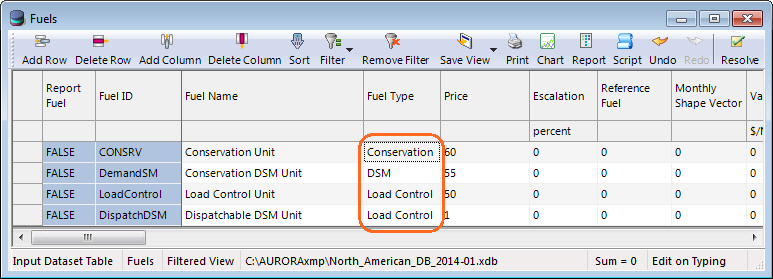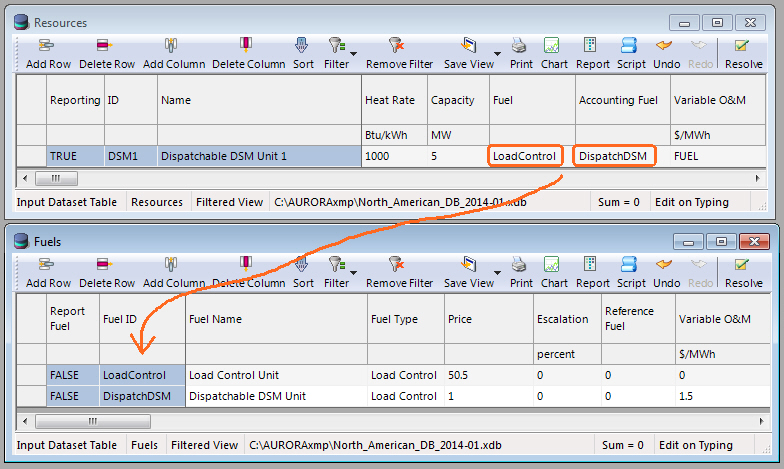Conservation or DSM Resources
Aurora provides the capability to implement Demand Side Management (DSM) or conservation units. DSM resources can be used to conveniently model Plug-in Hybrids, Load Shifting, Energy Efficiency Programs, Load Reduction, Load Reduction with Cost, etc. This capability is an extension of the storage shaping logic and is represented as a special kind of storage unit. While they affect the net load directly, DSM units are reported in their own columns in the zone and pool reports as Conservation_Output and Load_Control_Output.
There are two types of DSM specifications: Conservation and Dispatachable DSM. These types are specified by defining a Fuel Type as Conservation/DSM, or Load/Load Control. Any resource that is recognized by the model as a DSM resource can be scheduled to decrease or increase the zonal load on an hourly basis. This logic will “shift” demand, but it is not just limited to that - load can also be increased or decreased for specific hours without the reciprocal action.
![]() NOTE: DSM units are defined by the Fuel Type column in the Fuel table, NOT by the Fuel ID.
NOTE: DSM units are defined by the Fuel Type column in the Fuel table, NOT by the Fuel ID.

Conservation Resources
Conservation resources are defined with Fuel Type as Conservation or Demand Side Management (DSM). To define when a conservation resource will adjust demand, the Hourly Shaping Factor column of the Resources table is used. This can be a constant value or reference a Time Series Weekly vector. For any given hour, if the model sees a value of 1 in this column, it will trigger a reduction of zonal net load by the capacity of the conservation resource. Conversely, a value of -1 in the Hourly Shaping Factor column will trigger an increase in net load by the resource capacity.
If the Hourly Shaping Factor is a time series vector or a non-zero scalar, the resolved hourly values will be applied against the unit’s observed capacity at the beginning of each storage scheduling period (1 AM each Monday, and first hour of each month). Rules for the shaping factor are the same as those for forcing a storage schedule. Assuming the unit’s capacity is positive, a positive shaping factor will result in load reduction, a negative value will result in a load increase.
If the Hourly Shaping Factor field for a DSM unit is null or zero, the model will use hourly capability for the output of the unit. A positive hourly capability will result in load reduction, while a negative capability will cause a load increase.
![]() NOTE: Remember, the hourly shape for DSM units is controlled through the Hourly Shaping Factor column. If you try to apply a weekly shape to the capacity and set Hourly Shaping Factor field to zero you will not get hourly shaping. The best application is to set the capacity with no finer than monthly resolution, and control the hourly shaping by an entry in the Hourly Shaping Factor column that will resolve to a weekly vector. Those weekly values should be input as fractions of capacity.
NOTE: Remember, the hourly shape for DSM units is controlled through the Hourly Shaping Factor column. If you try to apply a weekly shape to the capacity and set Hourly Shaping Factor field to zero you will not get hourly shaping. The best application is to set the capacity with no finer than monthly resolution, and control the hourly shaping by an entry in the Hourly Shaping Factor column that will resolve to a weekly vector. Those weekly values should be input as fractions of capacity.
Dispatchable Load Control Resources
Dispatchable DSM resources are treated as standard resources that respond to price, but their output adjusts demand. They are defined with Fuel Type as Load or Load Control and operate such that dispatch costs are based on the main Fuel, however when the unit runs its costs are defined by the Accounting Fuel. According to the accounting fuel logic, the Variable O&M from the "dispatch" fuel will be used for the resource. In output, the Load Control device will be included in the Resource_Capability and operation reported in the Load_Control_Output columns.

Additionally, if a Load Control resource has a Fuel Type with the word Contract in it and it has negative capacity, the model will treat it differently. It will seek to dispatch it as if it had positive capacity (i.e., What the economics would be if it were reducing load), but if it actually dispatches it will increase load per the unit’s negative capability. This is meant to help model sale contracts that execute at a certain price.
Output
The output for these resources can be found in the Conservation_Output and Load_Control_Output columns in Zone and Pool output tables, and is also counted towards the Resource_Capability. In addition, the Demand column reflects any DSM or Conservation patterns (vs Baseline_Demand).
![]() Conservation or DSM Resources
Conservation or DSM Resources
